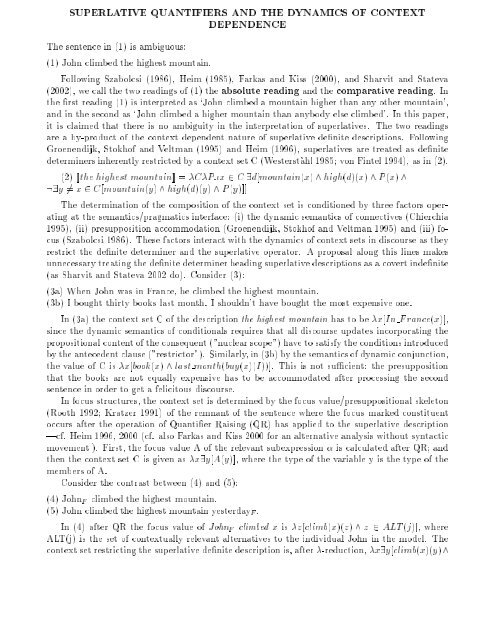SemPrag03.Progr.pdf - Institut für Linguistik/Germanistik - Universität ...
SemPrag03.Progr.pdf - Institut für Linguistik/Germanistik - Universität ...
SemPrag03.Progr.pdf - Institut für Linguistik/Germanistik - Universität ...
Create successful ePaper yourself
Turn your PDF publications into a flip-book with our unique Google optimized e-Paper software.
SUPERLATIVE QUANTIFIERS AND THE DYNAMICS OF CONTEXT<br />
DEPENDENCE<br />
The sentence in (1) is ambiguous:<br />
(1) John climbed the highest mountain.<br />
Following Szabolcsi (1986), Heim (1985), Farkas and Kiss (2000), and Sharvit and Stateva<br />
(2002), we call the two readings of (1) the absolute reading and the comparative reading. In<br />
the rst reading (1) is interpreted as `John climbed a mountain higher than any other mountain',<br />
and in the second as `John climbed a higher mountain than anybody else climbed'. In this paper,<br />
it is claimed that there is no ambiguity in the interpretation of superlatives. The two readings<br />
are a by-product of the context dependent nature of superlative denite descriptions. Following<br />
Groenendijk, Stokhof and Veltman (1995) and Heim (1996), superlatives are treated as denite<br />
determiners inherently restricted by acontext set C (Westerstahl 1985 von Fintel 1994), as in (2).<br />
(2) [[the highest mountain]] =CP:x 2 C 9d[mountain(x) ^ high(d)(x) ^ P (x) ^<br />
:9y 6= x 2 C[mountain(y) ^ high(d)(y) ^ P (y)]]<br />
The determination of the composition of the context set is conditioned by three factors operating<br />
at the semantics/pragmatics interface: (i) the dynamic semantics of connectives (Chierchia<br />
1995), (ii) presupposition accommodation (Groenendijk, Stokhof and Veltman 1995) and (iii) focus<br />
(Szabolcsi 1986). These factors interact with the dynamics of context sets in discourse as they<br />
restrict the denite determiner and the superlative operator. A proposal along this lines makes<br />
unnecessary treating the denite determiner heading superlative descriptions as a covert indenite<br />
(as Sharvit and Stateva 2002 do). Consider (3):<br />
(3a) When John was in France, he climbed the highest mountain.<br />
(3b) I bought thirty books last month. I shouldn't have bought the most expensive one.<br />
In (3a) the context set C of the description the highest mountain hastobex[In F rance(x)],<br />
since the dynamic semantics of conditionals requires that all discourse updates incorporating the<br />
propositional content of the consequent("nuclear scope") have to satisfy the conditions introduced<br />
bytheantecedent clause ("restrictor"). Similarly,in(3b)by the semantics of dynamic conjunction,<br />
the value of C is x[book(x) ^ last month(buy(x)(I))]. This is not sucient: the presupposition<br />
that the books are not equally expensive has to be accommodated after processing the second<br />
sentence in order to get a felicitous discourse.<br />
In focus structures, the context set is determined by the focus value/presuppositional skeleton<br />
(Rooth 1992 Kratzer 1991) of the remnant of the sentence where the focus marked constituent<br />
occurs after the operation of Quantier Raising (QR) has applied to the superlative description<br />
|cf. Heim 1996, 2000 (cf. also Farkas and Kiss 2000 for an alternative analysis without syntactic<br />
movement ). First, the focus value A of the relevant subexpression is calculated after QR and<br />
then the context set C is given as x9y[A(y)], where the type of the variable y is the type of the<br />
members of A.<br />
Consider the contrast between (4) and (5):<br />
(4) John F climbed the highest mountain.<br />
(5) John climbed the highest mountain yesterday F .<br />
In (4) after QR the focus value of John F climbed xis z[climb(x)(z) ^ z 2 ALT (j)], where<br />
ALT(j) is the set of contextually relevant alternatives to the individual John in the model. The<br />
context set restricting the superlative denite description is, after -reduction, x9y[climb(x)(y) ^

















